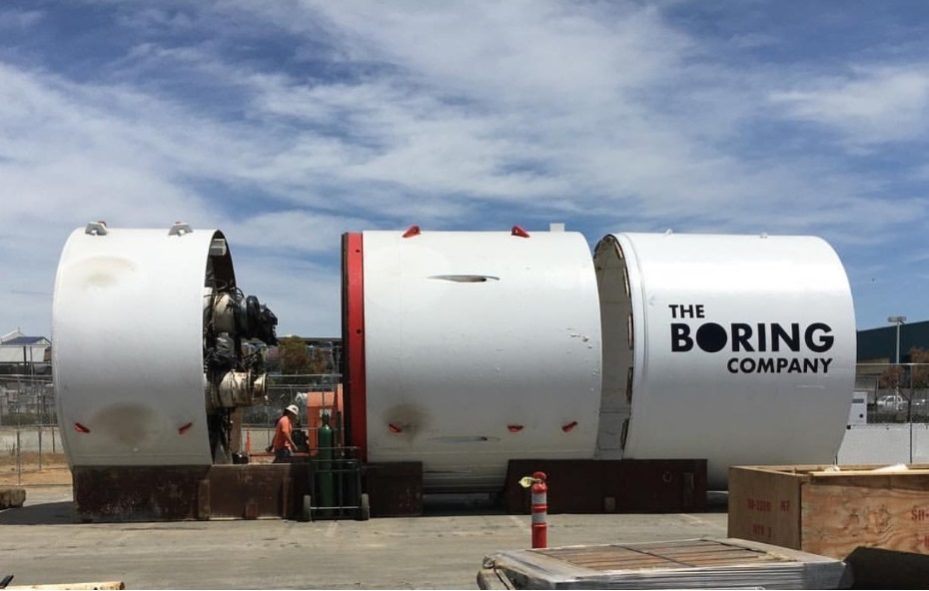Being stuck in heavy traffic on the roads of L.A gave Elon Musk the idea to start another company. Intended as a pun, The Boring Company is marching forward with its plan to dig 3-dimensional tunnels under cities to ease congestion and reduce traveling time.
We’ve already got a sneak peek of this initiative through a demonstration video (revealed at Musk’s recent TED talk) and pictures of the very first boring machine and tunnel site (shared by himself on Instagram). But, The Boring Company website has today been updated with an F.A.Q section to provide us with some nitty-gritties of what Musk is aiming for, with this ambitious new venture.
Choosing tunnels over flying cars
Tesla and SpaceX CEO Musk has already talked about most of the details of the boring venture on stage at his TED talk but has now penned it down to make the populace aware of his intentions. The website asserts that the company chose to bore tunnels instead of building flying cars because the latter would have to face issues with weather, noise and not failing mid-flight — the fear of falling on someone walking underneath.
Tunnels, on the other hand, are beneficial as they go down and remain under the surface of the Earth. Since the ground extends to greater depths, there is almost no limit to the number of layers of tunnels one can bore to address on-road congestion. Unlike flying cars, who’d need to install wipers, the tunnels are waterproof and won’t cause extreme noise when operational. The tunnels will also be earthquake-proof as there would be no falling debris at the Boring Company.
It’s not like others haven’t tried digging tunnels before Musk did. His stature and the drive to create something unthinkable has attracted eyeballs to this tunneling project, in huge numbers. And in his true fashion, he’s not sticking to the present industry standards, spending as much as $1 billion per mile, to bore these tunnels. Instead, he is looking to slash the tunneling costs by a factor of more than ten.
The Boring Company
Let’s keep the explanation of how Musk aims to keep the operational costs — one of his primary concerns, as already seen at SpaceX, Tesla, and SolarCity — at the Boring Company to a minimum.
Currently, Musk has purchased a second-hand Tunnel Boring Machine (TBM) and started digging the very first tunnel just a couple days ago. The standard speed of operation of this machine, as shown off via an Instagram video, is damn painful and slow. Thus, the plan is to increase this speed, such that it becomes faster than the Boring Company’s pet snail — Gary and Musk has more than a few ideas to make this a possibility:
[mks_accordion] [mks_accordion_item title=”Increase TBM power”] The Boring Company is planning to triple the machine’s power output, which has to coupled with relevant changes in its cooling systems as well.[/mks_accordion_item] [mks_accordion_item title=”Tunnel Continuously”] The website states that current TBMs are involved in crushing their way through soft-soil 50 percent of the time, while the other 50 percent is spent securing the structure. Upgrading the existing technology to tunnel and lay support round the clock is the objective.
[/mks_accordion_item] [mks_accordion_item title=”Automate the TBM”] This one is simple. The Boring Company presently employs a human operator to control the large TBM. It is aiming to automate the same to increase safety and efficiency.
[/mks_accordion_item] [mks_accordion_item title=”Go electric”] How can this not be an agenda on Musk’s plan? Tesla’s cutting-edge power generation and storage technology will enable Musk to electrify the machine, which currently runs on diesel.
[/mks_accordion_item] [mks_accordion_item title=”Conducting Tunnel R&D”] There is virtually no investment in tunneling (or any other forms of construction) Research and Development in the U.S. Thus, the construction industry is one of the only sectors of our economy that has not improved its productivity in the last 50 years.
[/mks_accordion_item] [/mks_accordion]
In addition, these costs are being primarily reduced by three to four time by making the tunnel smaller in diameter. To build a one-road tunnel, the website mentions that the tunnel diameter must be approximately 28 feet. This is being reduced to half by building a stabilized electric sled that will ferry your vehicles from one on-road tunnel location to another at speeds as high as 125 miles per hour in urban settings. It will be a zero-emission vehicle.
Hyperloop
Further, one cannot deny the fact that Musk also has (positive) ulterior motives for building underground tunnels across the globe. He is recognized as the individual behind surfacing the idea behind Hyperloop, a mechanism where magnetic levitation can be used to make pods travel at speeds as high as 600 miles per hour in a near vacuum tunnel.
Elon Musk only uploaded a rough six-page paper on SpaceX’s website in 2013 and multiple researchers+ventures have jumped on the bandwagon. They’ve been working to turn this concept into a reality for the last four odd year and are now close to testing their pods, as well as tracks to carry passengers and freight across long distances in mere minutes.
Maybe the idea of building tunnels was always in the back of Musk’s mind and he’s only acting upon the same now when Tesla and SpaceX both are performing exceptionally well. This network of tunnels if constructed using the upgraded tunneling machines will enable the company to normalize Hyperloop in the coming years. Talking about the same, the Boring Company website mentions:
Fast to dig, low-cost tunnels would also make Hyperloop adoption viable and enable rapid transit across densely populated regions, enabling travel from New York to Washington DC in less than 30 minutes.






